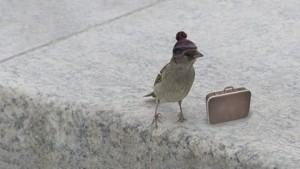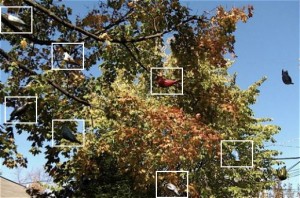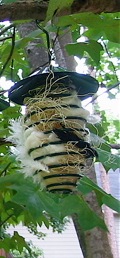- Bird Feeders, Bird Nesting Materials, Birding Accessories, Hummingbird Feeders, Nesting Material, Uncategorized, Window Hummingbird Feeder
get them buzzing at your window hummingbird feeder
With the mild winter season across most of the country this year, it won’t be too long before the hummingbirds are back! Unlike any other songbirds, the tiny sprites are really in a class of their own. If you already have them around your place, then you know what I mean. If not, this is the year to feed, plant, and attract them to your yard. The rewards are mesmerizing and tenfold! And, no birdseed to buy… you can make your own nectar from plain table, or cane sugar (no substitutes) and water.
To further entice hummingbirds to your window hummingbird feeder, moving water is always a huge attraction! Here are two other very cool accessories which promise
to bring them buzzing! Check out Pop’s Hummingbird Swing and video below, and Hummer Helper Nest Material (endorsed by The hummingbird Society).
Place this simple but elegant Hummingbird Swing near your feeder and hummingbirds will use it as a territorial perch to watch over their food source. Tested and trusted, check out the video below. Swing, Eat, Chase away other hummingbirds.. repeat! Enjoy!
Hummer Helper Nest Material has actually been endorsed by The Hummingbird Society as being the only commercial nest material that will increase visits to your window hummingbird feeder. By encouraging nesting, juveniles will follow parents to the feeders, and if the habitat is right… those same hummers will return next season! Site fidelity plays a huge role in hummingbird migration, if they find a place they like, they return to that place year after year. Pretty cool, huh?
-
from burbs to city with decorative bird houses
Some “birder” folks in big cities face a challenge when it comes to attracting desirable songbirds. It seems an unwelcome, furry rodent type, better known as the rat-is usually attracted to fallen seed and ground waste. But by no means do you have to abandon the birds!
Feeding suet leaves no waste or ground mess, and water in a birdbath are both effective, easy, and economical methods to entice birds. Oh… and let’s not forget birdhouses, because even in the city, birds need roosting spots and nesting cavities.
Kelle Frymire faced this dilemma when she moved from the suburbs of Chicago to the big city. With a suggestion from her long time friend and landscaper, Rocque Emlong, it was decided that decorative bird houses would be used to lure feathered friends. His creative idea spawned an almost magical tale, a display bringing smiles to many people, both young and old! Not just one or two houses… but 20-30 decorative bird houses (that actually look like birds) adorn an ancient oak tree next to Kelle’s house.
Hand carved decorative bird houses bring this old oak tree to life, with such character and charm that the neighbors delight, and local kids insist on saying “hi” to the birds on a daily basis! Some of the birdhouses sit suspended in animation between the the tree itself and the residence, using monofilament. The wooden birdhouses provide roosting spots on cold nights, and yes… even nesting cavities in early spring, You can read the full story on this magical creation here.
Birdhouses that look like birds? You bet! From Bobbo, Inc, these decorative bird houses are hand carved in Indonesia, using a quick-growth & renewable resource called Albesia wood. The houses are complete
with clean-outs and provide a perfect nest site for your avian amigos… with a very unique character all their own!
Thanks for housing the birds!
- Bird Accessories, Bird Nesting Materials, Fruit Bird Feeder, Nesting Material, Suet Feeders, Uncategorized
be ready for the season with homemade nesting materials
The cold weather of winter leaves behind some clues for us (if we look) from the previous busy season of the avian world. Simply look up and take notice. Barren-looking trees with their foliage stripped will reveal the nests of several species, and what they’ve used for nesting materials.
Large, messy nests are usually the work of squirrels, while a smaller nest consisting of twigs and grasses may be that of a Cardinal, Blue Jay, or Mockingbird. An even smaller nest with tightly woven plant fibers, maybe even some milkweed or thistle down still attached would be the work of an American Goldfinch. You’d have to search a bit harder to find nests from Bluebirds, Chickadees, or Nuthatches, as these birds nest in cavities or birdhouses. You can easily encourage nest building around your place this season by offering nesting materials before the season actually starts. Although there are many cool kinds of materials and holders available, this is most definitely a “do-it-yourselfer”!
Start by gathering nesting materials now. Feathers and pet hair are preferred by Chickadees, while decorative mosses (Spanish, Sphagnum, and that thin, curly straw-like stuff) might be used by many species mentioned above. Bright cotton yarns add a nice touch too, as variety is the spice of life. Although I’ve always heard that dryer lint is a good one… our local birds have never touched it when previously offered. Stay away from plastics, fishing line, and the like. These can get tangled around nestlings or their legs, proving to be hazardous, and sometimes fatal.
Now, what to put your nesting materials in? That part is simple! A standard suet cage works perfectly, as do the mesh produce bags from the grocery store (the kind apples come in). The
Spring Feeder shown here is just that, meant for fruit or suet. We’ve found whole peanuts and our nesting materials work great in them too. Talk about versatility! Put a mixture of materials in several holders and hang them from branches around your yard where the birds will see them. Do pull some materials through to get started, but don’t pack them in too tightly. Birds need to be able to pull them out fairly easily, and should the rain saturate the nesting material, it will dry quickly if air can flow through it. So start gathering… and here’s to many successful broods this season!








